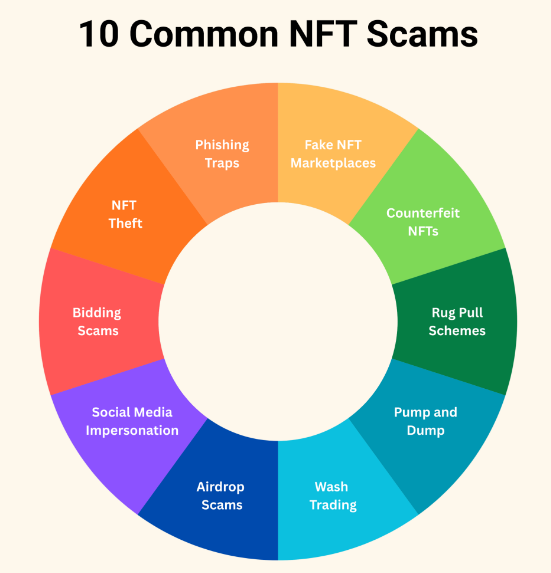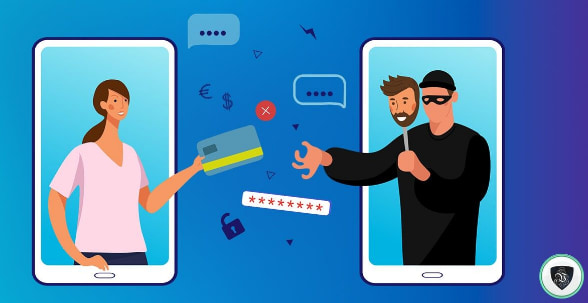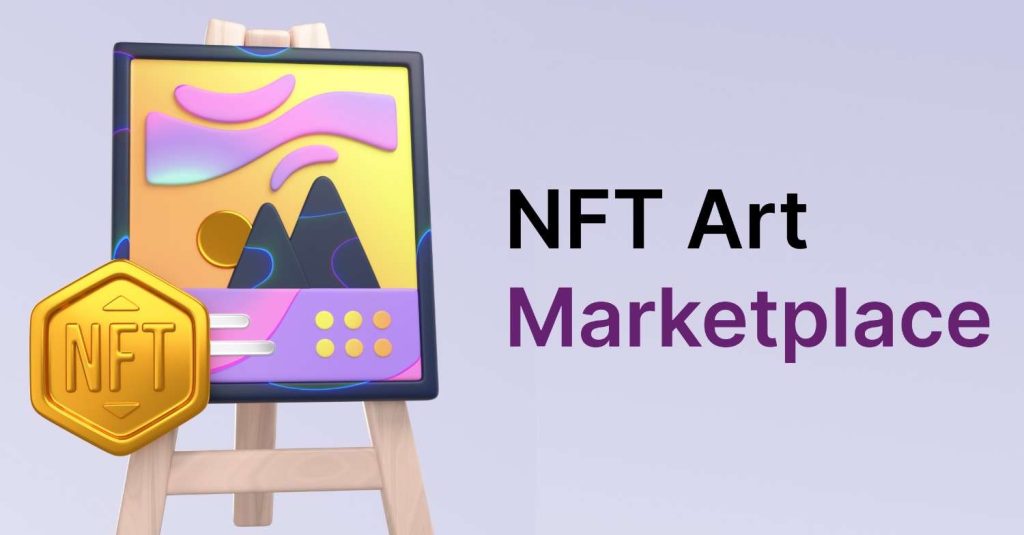There are numerous NFT scams, which include phishing attacks, fake marketplaces, rug pull schemes, pump-and-dump operations, and many more.
Typically, scammers create websites that appear identical to real NFT platforms and steal your wallet credentials. Some create hype for projects to steal money from investors.
However, you can protect yourself by verifying website URLs before logging in, researching project teams thoroughly, and never sharing your wallet’s recovery phrase with anyone.
This guide walks you through 10 major NFT scam types, warning signs to watch for, and practical steps to keep your digital assets safe.
Why You Need To Know About NFT Scams?
NFT scammers take an average of $300,000 per fraud event, which makes each attack financially devastating for victims.
Over $100 million in NFTs were reported stolen between July 2021 and July 2022; however, the actual number is likely higher, as many thefts go unreported.
The market operates without central regulation, leaving you at risk if you are unaware of the warning signs. Even experienced investors fall victim because scammers constantly evolve their tactics.
Learn to spot these schemes before you invest to protect your money and save you from the frustration of losing valuable digital assets to criminals.
What Makes NFTs a Target for Scammers?
The NFT market remains unregulated, with no central oversight body monitoring price manipulations or fraudulent activity.
NFTs are valuable only to buyers and traders who purchase, invest in, and trade them. Scammers can trick such people by creating fake sales or paying celebrities to promote their products.
To be more straightforward, people on Reddit compare NFTs to Beanie Babies and say many don’t trust them. Users point out that when you buy an NFT, you only get a link to an image.
You don’t get actual ownership of the image itself. Many people don’t understand what NFTs really are. This makes it easy for scammers to trick them by promising things they won’t actually deliver.
The Most Common NFT Scams
The most common NFT scams are phishing traps, fake marketplaces, or dummy NFTs. There are many reasons for NFT scams that you will see here in this section to be aware of.

1. Phishing Traps
Scammers build websites that look similar to official NFT marketplaces such as OpenSea or Rarible. When you enter your login details or wallet recovery phrase on these fake sites, criminals capture this information instantly.
They then access your actual wallet and steal everything inside. Always check the website URL carefully before entering any personal information.
2. Fake NFT Marketplaces
Scammers create entire fake trading platforms with professional designs and dummy user reviews. You connect your wallet to buy an NFT, complete the transaction, and receive a worthless token.
Then the scammers immediately disappear with your cryptocurrency payment. The platform shuts down within days, leaving no way to contact anyone or recover your money.
3. Counterfeit NFTs
Fraudsters download popular NFT artwork and mint copies, pretending to have created the original pieces. They sell these fake versions at lower prices to attract buyers quickly.
You think you bought a valuable collectible, but you own a worthless copy with no connection to the real creator. Always verify that the contract address matches the official collection before making a purchase.
4. Rug Pull Schemes
Developers create exciting NFT projects with big promises about future games, exclusive benefits, or virtual worlds. They build hype on social media and collect money through pre-sales.
Once they reach their fundraising goal, the team deletes all social media accounts and vanishes with the cash. You’re left holding NFTs with zero value and no working project.
5. Pump and Dump
A group of scammers uses social media influencers and celebrity endorsements to create excitement around specific NFTs. They buy these NFTs at low prices first, then promote them heavily to drive up demand.
Once prices peak and new buyers rush in, the scammers sell everything at once. Prices crash immediately, leaving new buyers with worthless assets. This is similar to rug pull schemes.
6. Wash Trading
Fraudsters create multiple wallet addresses that they control secretly. They repeatedly sell NFTs between these wallets to create the illusion of high trading activity.
This makes the NFT look popular and valuable to outside buyers. When you check the blockchain history, you see many sales, but they’re all by the same person, creating false demand.
7. Airdrop Scams
Someone sends a free NFT directly to your wallet without warning. To claim or view this NFT properly, you must connect your wallet to their website and approve a transaction.
This approval gives scammers full access to steal everything in your wallet. Some airdropped NFTs also contain malware that infects your device when you open them.
8. Social Media Impersonation
Fraudulent people create accounts that appear to be official customer support for NFT platforms. They contact you on Discord, Twitter, or Reddit, claiming there’s a problem with your account.
Then, they might ask for your wallet recovery phrase to “fix the issue” or send you links to fake websites. Note that real support teams never ask for your recovery phrase or private keys.
9. Bidding Scams
I will explain this with an example. Let’s say you list your NFT for sale at 10 ETH and receive a bid for 12 ETH, which is a great offer. However, the buyer switches the cryptocurrency type right before you accept.
You end up receiving 12 DAI or USDC instead, which are worth only about twelve dollars. Therefore, it is best always to double-check which cryptocurrency the bid uses before accepting any offer.
10. NFT Theft
Hackers gain access to your wallet by tricking you into signing fake transactions or clicking on malicious links. They transfer all your NFTs and cryptocurrency to their own wallets within minutes.
Stolen NFTs get sold immediately to automated bots at very low prices before you notice anything missing. Once transferred to the blockchain, recovery becomes nearly impossible.
How To Spot a Scam Before You Become a Victim?
Here are some ways to spot a scam beforehand and avoid suspicious sites to stay financially safe.

- Anonymous development team – The project creators use fake names or hide their real identities completely.
- Unrealistic profit promises – Fraudsters guarantee you will make money or promise extremely high returns quickly.
- Urgent pressure tactics – You feel rushed to buy now, or they say the opportunity will disappear soon.
- Vague project roadmap – The future plans sound exciting, but lack specific details or clear timelines.
- Suspicious website URLs – The web address has spelling mistakes or looks slightly off from official website URLs.
- Requests for private keys – Never share your wallet recovery phrase or private keys with anyone.
- Price too low – The NFT costs much less than other items in the same collection. Avoid trusting sites that offer NFTs at extremely low prices.
- Unverified social accounts – The social media profiles lack verification checkmarks or have very few genuine followers.
- Repeated wallet trading – The same wallet addresses keep buying and selling the NFT to themselves.
- No security audit – No trusted company has checked the smart contract for safety or problems, so step into the NFT world wisely for trading.
What To Do If You’ve Been Scammed?
Take quick action if you have been scammed, which can help limit the damage. A 2022 case highlighted how easily people fall victim when someone mints an NFT, sells it to themselves for a high price, and then resells it to an unsuspecting buyer who thinks they got a discount.
Here’s what you should do immediately:
- Report the NFT as stolen on the marketplace platform.
- Move all remaining assets to a completely new wallet.
- Document everything with screenshots and transaction records.
- Contact the platform to freeze or delist the fraudulent NFT.
- Report the scam to the FBI, FTC, and SEC.
Check if you qualify for the SEC Whistleblower Program, which may offer recovery awards. Getting your money back might be difficult, but reporting helps protect others from the same scammer.
Prevention Tips To Avoid NFT Scams
Here are some prevention tips to avoid NFT scams and falling for any fraudulent activity.

- Choose Your Platform Wisely:
Use well-known marketplaces like OpenSea, Rarible, or Foundation that require identity verification. Always check the website URL carefully before logging in.
The best thing you can do is bookmark official sites to avoid clicking phishing links. Look for verification badges and read user reviews before making any purchase.
- Secure Your Digital Wallet:
Store valuable NFTs in cold storage hardware wallets rather than online hot wallets. Enable two-factor authentication on all accounts.
Create strong passwords using a password manager. Remember that no legitimate platform will ever ask you for your seed phrase or recovery words under any circumstances.
- Take Time To Research Carefully:
Verify the seller’s complete transaction history on the blockchain before making a purchase. See that trusted security firms have audited smart contracts.
Cross-check NFT prices on multiple platforms to spot unusual pricing. Join the project’s community channels, but always verify links through official sources first to avoid fakes.
- Practice Good Cybersecurity Habits:
Never click links from emails or direct messages without verifying the sender first. Use VPN services when making transactions.
Check if smart contracts request unlimited access to your tokens and revoke these permissions immediately after transactions are complete to protect your remaining assets.
- Start Small and Stay Skeptical:
Only invest money you can afford to lose completely. Take time to research projects thoroughly rather than rushing into purchases.
Avoid making decisions based on fear of missing out or celebrity endorsements. Remember that legitimate projects never pressure you into immediate action or guaranteed returns.
Conclusion: Spot NFT Scams and Frauds Before Any Financial Loss
You can spot scams and frauds through fake names, unreal IDs, mistakes in duplicate website addresses of the official ones, and a lack of specific details regarding the platform’s authenticity.
Understand the most common types of scams, such as phishing, fake NFT marketplaces, or rup pull schemes. There are many more scams mentioned in this article that you should consider before making any investment in NFTs.
Purchase, sell, invest, and trade wisely in NFTs to avoid scams and fraudulent activities.
FAQs
Check the URL carefully for spelling mistakes or extra characters that differ from the official site. Legitimate platforms have verification badges and secure HTTPS connections throughout.
Scammers send unsolicited NFTs as bait or a trap to trick you into connecting your wallet to their malicious websites when you try to claim or view them.
Ignore them and never attempt to claim, sell, or interact with unexpected NFTs in your wallet. Consider moving your legitimate assets to a new wallet.
NFTs only hold value if someone else agrees to pay for them. Most NFTs today have little to no value, despite what sellers originally promised to buyers.
Check their wallet’s transaction history on the blockchain for suspicious patterns. Legitimate buyers have diverse trading activity and an established account history, with multiple verified transactions.

